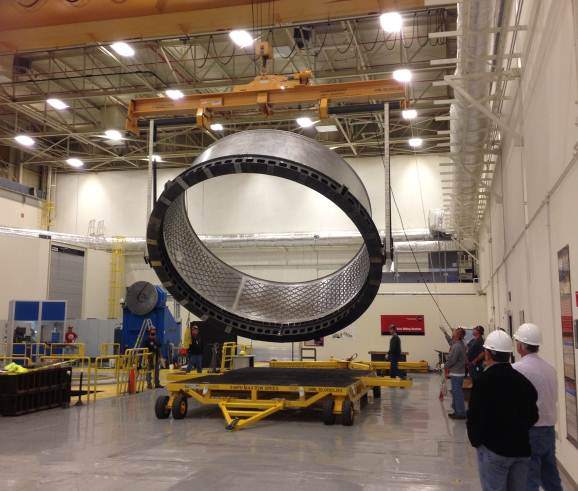Engineers at NASA’s Marshall Space Flight Center in Huntsville, Ala., recently flipped an adapter – no easy feat when you’re talking about 1,000 pounds of aluminum – furthering progress toward Exploration Flight Test (EFT)-1 in 2014 and providing early experience for Space Launch System (SLS) hardware ahead of the rocket’s first flight in 2017.
The flip is an important step in finishing the machining work on the adapter, which will attach NASA’s Orion spacecraft to a United Launch Alliance (ULA) Delta IV rocket that will send Orion to space during EFT-1.

The same adapter technology later will connect Orion to SLS — a new heavy-lift rocket managed and in development at Marshall that will be capable of sending Orion into deep space.
During EFT-1, Orion will travel to an altitude of approximately 3,600 miles above Earth’s surface. By flying Orion out to those distances, NASA will be able to see how the spacecraft performs in and returns from deep space journeys. The flight test also will provide engineers with important data about the adapter’s performance before it is flown on SLS.
Engineers finished welding on the first of two adapters and flipped it using a Posi-Turner load rotation device and an Assembly Jig, the ring that connects the Posi-Turner to the bottom of the adapter and rotates it.
“The Posi-Turner and Assembly Jig were repurposed from another program, so we had to modify them a bit to fit our needs to rotate the adapter,” said Brent Gaddes, Spacecraft & Payload Integration Adapter Subsystem manager at Marshall. “Our engineers are really good at coming up with creative ways to use existing resources in a cost-effective manner.
“Affordability is crucial when you’re talking about building a rocket as big and powerful as the Space Launch System,” added Gaddes.
“It’s very exciting as a young engineer to be able to work on a piece of flight hardware, and see it go from design to actual manufacturing,” said Zenia Garcia, a Marshall engineer who worked on the design for fitting the adapter to the Assembly Jig and Posi-Turner tooling. “I’ve had the opportunity to exercise my technical expertise, as well as get hands-on experience on this project. I look forward to seeing that work take Orion, and SLS, to space in the near future.”
Now that the adapter is flipped and positioned on a seven-axis mill turntable at one of Marshall’s manufacturing facilities, engineers will drill hundreds of holes in it for bolting to the rest of the rocket. ULA, which makes the Delta IV in nearby Decatur, Ala., will deliver a full-size section of the rocket in late June for engineers to test the fit of the adapter.
Circumferential welding also was recently completed on a second adapter, which will fly on EFT-1. That adapter will be moved from another Marshall manufacturing facility to the Assembly Jig/Posi-Turner for its own flip and final machining work.
So why have twin adapters?
“It’s always important to test something before it actually flies,” said Gaddes. “Analysis on the first adapter, which we are using as a structural test article, gives us a good indication of the amount of stress it can handle, and the test verifies that the analysis is correct. We can resolve any issues with the first adapter to perfect the second piece for flight.”
The adapters, along with other SLS components, are currently under evaluation at the Spacecraft & Payload Integration Office preliminary design review, which kicked off May 15. The review is a precursor to the overall SLS program preliminary design review, scheduled to kick off June 18-19.






